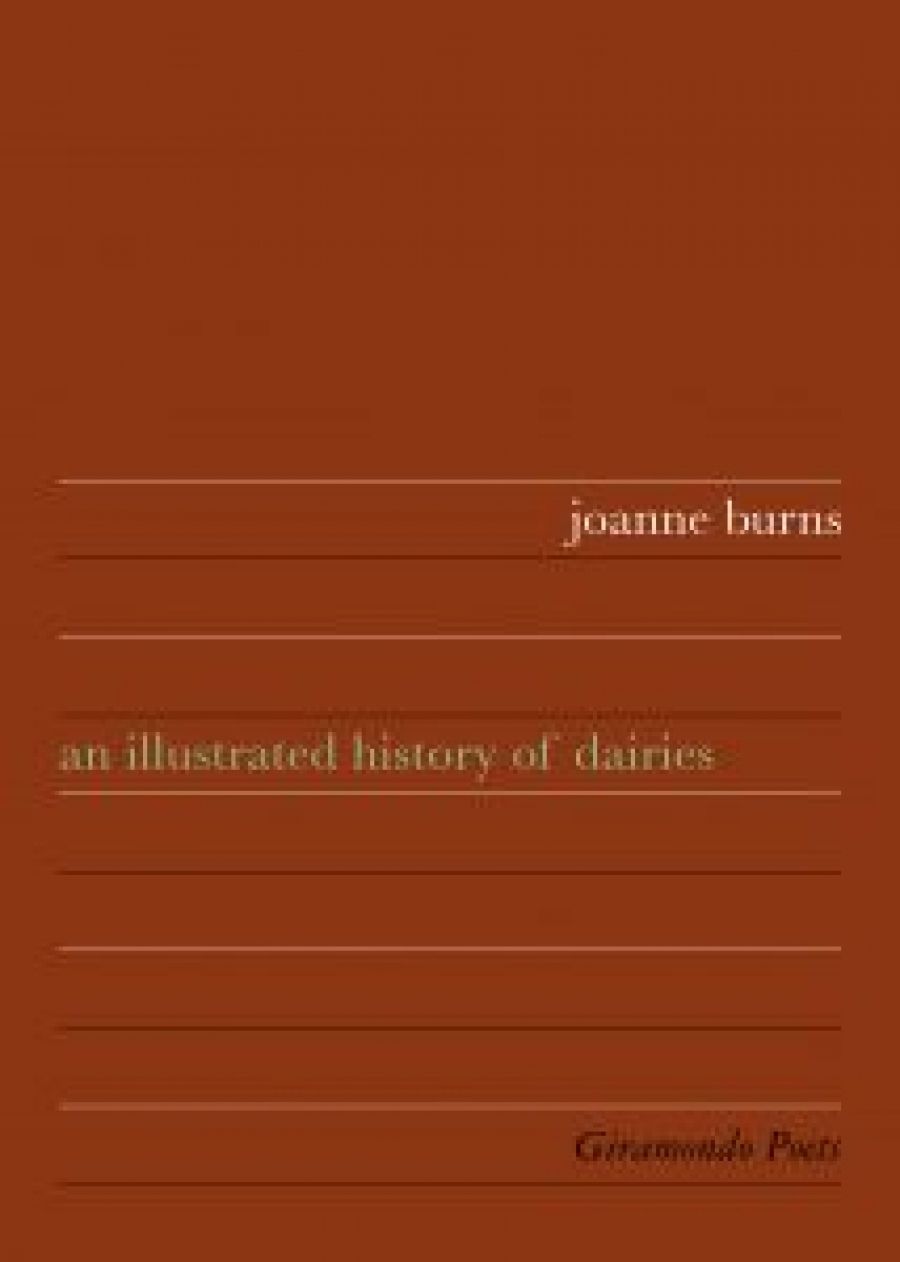
- Free Article: No
- Contents Category: Australian Poetry
- Custom Article Title: Susan Sheridan reviews 'An Illustrated History of Dairies' by joanne burns
- Review Article: Yes
- Article Title: Femina Ludens
- Online Only: No
- Custom Highlight Text:
joanne burns: There’s a name to conjure with. The familiar lowercase signature – first encountered in my now-tattered copies of 1970s women’s poetry magazines such as Khasmik and Cauldron, and in the anthologies Mother, I’m Rooted (1975) and No Regrets (1979) – now appears on burns’s fourteenth book. An Illustrated History of Dairies offers a generous selection of her verse and prose poems, including the satires on (sub)urban life for which she is well known, condensed narrative pieces, enigmatic fragments linked by flashes of surrealist wit.
- Book 1 Title: An Illustrated History of Dairies
- Book 1 Biblio: Giramondo, $22 pb, 112 pp
… he had a heart too soon made
sad, broken romance bad investments, his crying made me
stiff, but i answered all his commands until they stopped;
he wanted to be me …... he swallowed batteries till he choked,
‘i’m robot’, he roared beforehand, ‘not robert!’ – too much
crack and cocaine
they said when I buzzed SOS …... i’m going
to do some cryptograms in my nanobrain; I’m so fed up with
all my programs,
i think i wish to hatch a plan –
In other poems the use of ‘we’ or ‘you’ invites the audience into a wry complicity. ‘It slipped my mind’, opens with an echo of A.D. Hope’s ‘a Nation of trees’ (‘Australia): ‘a nation of empty shop fronts / crammed with spectral commodities … ’ before moving towards the inclusive ‘we’:
… the
dna of the permanent bargain:
he ordinary special is
the special ordinary we’re all
ORDS here; so who can we
afford
A poet whose work abounds with surrealist images and incongruities might want to distract her audience from looking too closely for logical connections, by demanding that we listen as attentively as we look. After all, randomness is the point, and the forward movement created by these unexpected conjunctions is crucial to the poetry’s emotional effect.
The rhythmic and tonal qualities of the writing carry emotions of pleasure and anxiety into burns’s perceptions of the everyday, as much as they sound notes of fear and horror in the poems’ intimations of mortality. Reviewers of her previous book, the award-winning Footnotes of a Hammock (2004), made a point of welcoming the new elegiac dimension of her work. This stream continues in the present volume, in the (apparently) autobiographical memoir of ‘the grandmother i never saw or touched or knew’ (‘Spray’), but death is pervasive. Sinister statements and images are dropped into larger structures (e.g., ‘I have cancer’ in the middle of section two of the final sequence, ‘Pack’). The theme of mortality does not inaugurate a different, more expressive poetry. Rather, I think, it serves to underscore and darken burns’s characteristic complex wit, as in
the wall longs to be rubble. it has watched other walls, buildings, demolished, collapsed over the decades … but not this wall, a ‘heritage’ wall. no one can touch it … the wall has begun to despise itself, is tired of standing, standing, enduring … it wants to lie flat on the ground and explode. into something new. rubble. (‘diversions’)
Death is also the subject of the title poem. It begins: ‘the skull in the 16th century painting is / usually well behaved but today it wants an / icecream it’s bored … ’ After some play with the idea of ice cream fashions and what a sixteenth-century ice cream would be like (‘sweet yorick on a stick’), the speaker alludes to Wallace Stevens’s famous poem ‘The Emperor of Ice-Cream’, recalling its extraordinary image of death and also invoking Stevens as an ancestor of this kind of poem:
now getting back to the skull:
i’m sure it’s not looking to be
the dead emperor of icecream or
an emperor of dead icecream it would
just like something cool and delicious
dribbling over what was once its mouth …
The skull as memento mori is undermined by this sensuousness, and the presence of death can even be forgotten. Objects – the skull, the wall – can experience desire and fear. Anything can happen. The poems are often like the early surrealist collages that juxtaposed incongruous elements and objects so that they interact randomly. Sometimes the connections are too oblique altogether, but it is nevertheless clear that burns is engaged in remaking surrealism for the twenty-first century – like many women writers before her, making its revolutionary play with language her own.


Comments powered by CComment